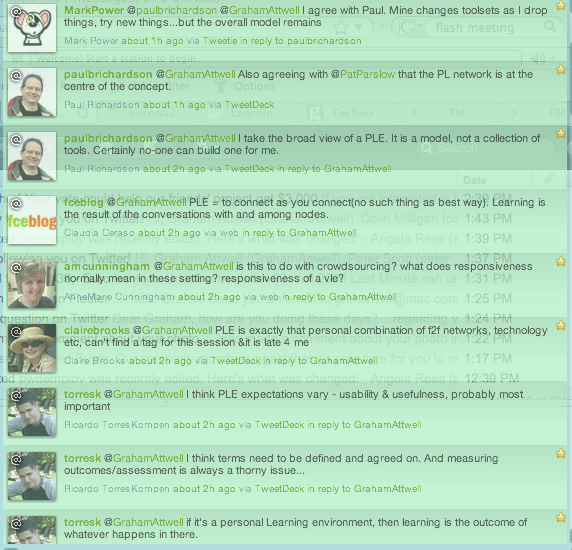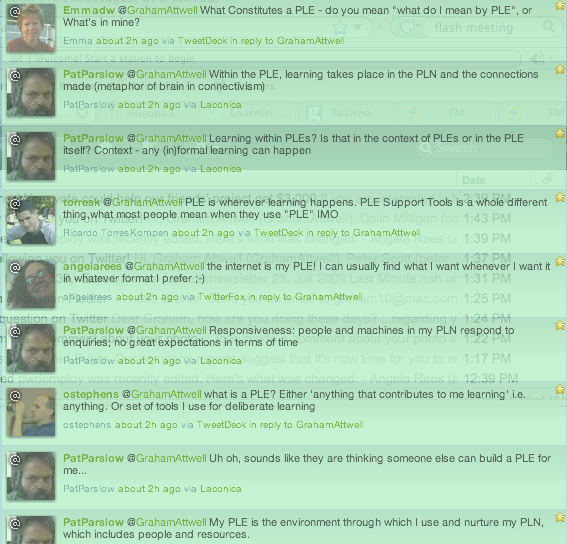Along with John Cook and Andrew Ravenscroft from London Metropoliatn University, I have submitted a paper to the 2nd World Summit on the Knowledge Society (WSKS 2009) to be held in Crete in September. Our paper, entitled ‘Appropriating technologies for contextual knowledge: Mobile Personal Learning Environments’, looks at the potential of what we call a Work Oriented MoBile Learning Environment (WOMBLE). The abstract goes like this:
“The development of Technology Enhanced Learning has been dominated by the education paradigm. However social software and new forms of knowledge development and collaborative meaning making are challenging such domination. Technology is increasingly being used to mediate the development of work process knowledge and these processes are leading to the evolution of rhizomatic forms of community based knowledge development. Technologies can support different forms of contextual knowledge development through Personal Learning Environments. The appropriation or shaping of technologies to develop Personal Learning Environments may be seen as an outcome of learning in itself. Mobile devices have the potential to support situated and context based learning, as exemplified in projects undertaken at London Metropolitan University. This work provides the basis for the development of a Work Orientated MoBile Learning Environment (WOMBLE).”
Below is the key section of the paper explaining about the environment. And I am also attaching a word file if you wish to download the full paper. As always I would be very interested in any feedback.
“Educational technology has been developed within the paradigm of educational systems and institutions and is primarily based on acquiring formal academic and expert sanctioned knowledge.
However business applications and social software have been widely appropriated outside the education systems for informal learning and for knowledge development, through social learning in communities of practice.
Is it possible to reconcile these two different worlds and to develop or facilitate the mediation of technologies for investigative and learning and developing developmental competence and the ability to reflect and act on the environment?
Based on the ideas of collaborative learning and social networks within communities of practice, the notion of Personal Learning Environments is being put forward as a new approach to the development of e-learning tools [25,26]. In contrast to Virtual Learning environments, PLEs are made-up of a collection of loosely coupled tools, including Web 2.0 technologies, used for working, learning, reflection and collaboration with others. PLEs can be seen as the spaces in which people interact and communicate and whose ultimate result is learning and the development of collective know-how. A PLE can use social software for informal learning which is learner driven, problem-based and motivated by interest – not as a process triggered by a single learning provider, but as a continuing activity. The ‘Learning in Process’ project [27] and the APOSDLE project [28] have attempted to develop embedded, or work-integrated, learning support where learning opportunities (learning objects, documents, checklists and also colleagues) are recommended based on a virtual understanding of the learner’s context. While these development activities acknowledge the importance of collaboration, community engagement and of embedding learning into working and living processes, they have not so far addressed the linkage of individual learning processes and the further development of both individual and collective understanding as the knowledge and learning processes mature [29]. In order to achieve that transition (to what we term a ‘community of innovation’), processes of reflection and formative assessment have a critical role to play.
John Cook [30] has suggested that Work Orientated MoBile Learning Environments (Womble) could play a key role in such a process. He points out “around 4 billion users around the world are already appropriating mobile devices in their every day lives, sometimes with increasingly sophisticated practices, spawned through their own agency and personal/collective interests.”
However, in line with Jenkins at al [31] it is not just the material and functional character of the technologies which is important but the potential of the use of mobile devices to contribute to a new “participatory culture.” They define such a culture as one “with relatively low barriers to artistic expression and civic engagement, strong support for creating and sharing one’s creations, and some type of informal mentorship whereby what is known by the most experienced is passed along to novices… Participatory culture is emerging as the culture absorbs and responds to the explosion of new media technologies that make it possible for average consumers to archive, annotate, appropriate, and recirculate media content in powerful new ways.”
The specific skills that Jenkins and his coauthors describe as arising through involvement of “average consumers” in this “participatory culture” include ludic forms of problem solving, identity construction, multitasking, “distributed cognition,” and “transmedial navigation.”
Importantly modern mobile devices can easily be user customized, including the appearance, operation and applications. Wild, Mödritscher and Sigurdarson [32] suggest that “establishing a learning environment, i.e. a network of people, artefacts, and tools (consciously or unconsciously) involved in learning activities, is part of the learning outcomes, not an instructional condition.” They go on to say: “Considering the learning environment not only a condition for but also an outcome of learning, moves the learning environment further away from being a monolithic platform which is personalisable or customisable by learners (‘easy to use’) and heading towards providing an open set of learning tools, an unrestricted number of actors, and an open corpus of artefacts, either pre-existing or created by the learning process – freely combinable and utilisable by learners within their learning activities (‘easy to develop’). ”
Critically, mobile devices can facilitate the recognition of context as a key factor in work related and social learning processes. Cook [33] proposes that new digital media can be regarded as cultural resources for learning and can enable the bringing together of the informal learning contexts in the world outside the institution with those processes and contexts that are valued inside the intuitions.
He suggests that informal learning in social networks is not enabling the “critical, creative and reflective learning that we value in formal education.”
Instead he argues for the scaffolding of learning in a new context for learning through learning activities that take place outside formal institutions and on platforms that are selected by learners.
Cook [30] describes two experimental learning activities for mobile devices developed through projects at London Metropolitan University. In the first, targeted at trainee teachers an urban area close to London Metropolitan University, from 1850 to the present day, is being used to explore how schools are signifiers of both urban change and continuity of educational policy and practice.
The aim of this project is to provide a contextualised, social and historical account of urban education, focusing on systems and beliefs that contribute to the construction of the surrounding discourses. A second aim is to scaffold the trainee teachers’ understanding of what is possible with mobile learning in terms of field trips. In an evaluation of the project, 91% of participants thought the mobile device enhanced the learning experience. Furthermore, they considered the information easy to assimilate allowing more time to concentrate on tasks and said the application allowed instant reflection in situ and promoted “active learning” through triggering their own thoughts and encouraging them to think more about the area
In the second project, archaeology students were provided with a tour of context aware objects triggered by different artifacts in the remains of a Cistercian abbey in Yorkshire. The objects allowed learners to expire not only the physical entity of the reconstructed abbey through the virtual representation, but also to examine different aspects including social and cultural history and the construction methods deployed. According to Cook [30] “the gap between physical world (what is left of Cistercian), virtual world on mobile is inhabited by the shared cognition of the students for deep learning.”
The use of the mobile technology allowed the development and exploration of boundary objects transcending the physical and virtual worlds. Boundary objects have been defined as “objects which are both plastic enough to adapt to local needs and constraints of the several parties employing them, yet robust enough to maintain a common identity across sites. They are weakly structured in common use, and become strongly structured in individual-site use. They may be abstract or concrete. They have different meanings in different social worlds but their structure is common enough to more than one world to make them recognizable means of translation. The creation and management of boundary objects is key in developing and maintaining coherence across intersecting social worlds.” [33]. The creation and management of boundary objects which can be explored through mobile devices can allow the interlinking of formal and academic knowledge to practical and work process knowledge.
Practically, if we consider models for personalized and highly communicative learning interaction in concert with mobile devices, whilst employing context aware techniques, startling possibilities can arise. For example, we can combine the immediacy of mobile interaction with an emergent need for a collaborative problem solving dialogue, in vivo, during everyday working practices, where the contextual dimensions can constrain and structure (through semantic operations) the choices about a suitable problem solving partner or the type of contextualised knowledge that will support the problem solving. In brief, combining dialogue design, social software techniques, mobility and context sensitivity means we have greater opportunities for learning rich dialogues in situations where they are needed – to address concrete and emergent problems or opportunities at work.
Such approaches to work oriented mobile learning also supports Levi Strauss’s idea of bricolage [34]. The concept of bricolage refers to the rearrangement and juxtaposition of previously unconnected signifying objects to produce new meanings in fresh contexts. Bricolage involves a process of resignification by which cultural signs with established meanings are re-organised into new codes of meaning. In such a pedagogic approach the task of educators is to help co-shape the learning environment.
Of course, such approaches are possible using social software on desktop and lap top computers. The key to the mobile environment is in facilitating the use of context. This is particularly important as traditional elearning, focused on academic learning, has failed to support the context based learning inherent in informal and work based environments.
Whilst the use of context is limited in the experiments undertaken by London Metropolitan University, being mainly based on location specific and temporal factors, it is not difficult to imagine that applications could be developed which seek to build on wider contextual factors. These might include tasks being undertaken, the nature of any given social network, competences being deployed, individual learner preferences and identities and of course the semantic relations involved.”
You can download the full paper here


